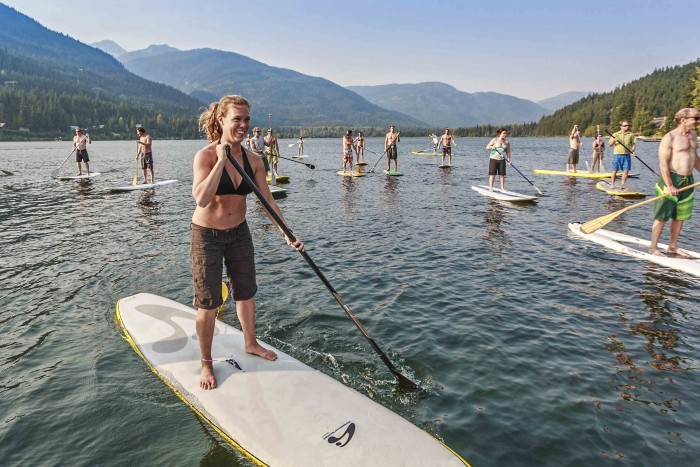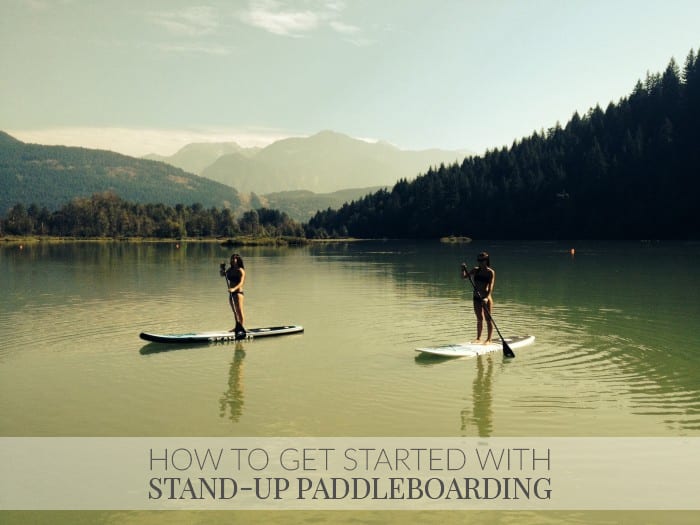Have you ever watched people gliding gracefully across the water on paddleboards and wondered how they do it? I did, too! I imagined myself soaking in the sunshine on calm waters, exploring the coastlines and enjoying the moments.
Stand-Up Paddleboarding, or SUP, is a fun sport that’s easy to get hooked on! This past summer I took the plunge, booked some lessons, and got myself out into the water. At first, I felt clumsy and awkward, and I was terrified of falling into the water! But soon, I was gliding along (not gracefully at first) and I loved every moment of it.
Here are some tips on how to get started with stand-up paddleboarding.
1. Take a Lesson
The first couple of times on a stand-up paddleboard should be with a trainer or an experienced friend. You need to learn basic techniques and stances so you can get comfortable on the water, and safely learn the sport. When you’re new to the sport, it also helps to start on calm, flat and open waters.
2. Getting Geared Up
A bonus in taking a lesson is that the gear is provided for you – a paddleboard, a paddle, and a personal floatation device. Be sure to wear a bathing suit, shorts or a t-shirt – clothing that can get wet and move with you. Depending on the water temperature, you might also want to wear a wetsuit or drysuit to keep you warm. Sun protection is a huge must and wearing a sunscreen with high SPF along with sunglasses is recommended.
3. Don’t Be Afraid to Get Wet!
When you first step onto a paddle board, your body and mind are working together to keep you balanced on the board – and the fear of falling into the water becomes real. And silly, right? It’s a water sport! Rather than holding your breath and waiting to accidentally fall in, jump in on purpose! After getting over the initial shock that you’ve survived, you can comfortably get on your board without any fear of falling in.

4. Stand Up!
When you first mount your board, you might find it easier to kneel on the board rather than stand upright, and that’s okay! Some people spend a whole lesson getting used to their board this way. Once you feel comfortably balanced, stand up slowly, one foot at a time. The proper stance is feet parallel, hip distance apart with toes pointed forward, knees bent and back straight. Keep your body relaxed – try not to tense up your shoulders or lock up your knees. To stay balanced, keep your gaze at the horizon and soak in the movement of the water.
5. Paddle!
Once you’ve got the hang of standing on your board, it’s time to start paddling! Start with which side feels more natural for you – if you’re paddling on the right, your right hand is on the shaft of the paddle, while you’re left hand will be on top of the grip. To paddle, keep your arms straight and use your torso to twist and paddle, pushing down on the paddle grip with your top hand. Keep your strokes fairly short at first, and close to the board. Once you get the hang of it, you can start going faster, switching arms, and learning how to turn your board.
When you’ve mastered the basics of stand-up paddleboarding, the fun really starts and you can start to learn different techniques in turning and paddling, as well as trying out faster waters.
Be sure to check out a SUP Yoga class in your area too – doing downward dog while balancing on a board can really change your perspective on meditation!
have you tried stand-up paddleboarding?
Think this post is worth a read? Please share – I’d greatly appreciate it! :)
[Tweet “How to Get Started with Stand-Up Paddleboarding”]


